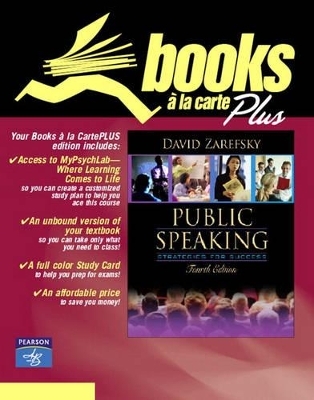
Public Speaking
Pearson
978-0-205-48370-9 (ISBN)
- Titel ist leider vergriffen;
keine Neuauflage - Artikel merken
David Zarefsky, one of today's leading scholars in speech communication, encourages students to think through and about the public speaking process. Zarefsky urges students to consider the diversity of audiences, occasions, and speakers and to choose a specific purpose, a relevant topic, and the appropriate material to make their speeches successful. The new edition focuses on providing students with more diverse and clearer examples, updated information on technology and its role in public speaking, and a strong balance of theory and skills.
This affordable Books à la Carte Plus Edition features the exact same content from our traditional textbook in a convenient, notebook-ready loose-leaf format – allowing students to take only what they need to class. As a bonus, the Books à la Carte Plus Edition is accompanied by a full-color, laminated Study Card that’s a perfect tool to help students prepare for exams, plus an access code to the MyLab for this course.
I. FOUNDATIONS OF PUBLIC SPEAKING.
1. Welcome to Public Speaking.
Why Study Public Speaking?
Public Speaking and Communication.
The Rhetorical Situation.
Goals and Strategies for Your First Speech.
Strategies for Organizing Your Speech.
Beginning Assignments.
Practicing the Speech.
Strategies for Overcoming Speech Anxiety.
The Quest for Quality.
Ethics: Respect for Audience, Topic, and Occasion.
2. Listening Critically.
Are You Really Listening?
Strategies for Careful Listening.
Listening Critically.
Evaluating Speeches Critically.
3. Analyzing Your Audience.
Checking Audience Demographics.
Respecting Audience Culture.
Understanding Audience Psychology.
Strategies for Analyzing the Audience.
Analyzing Your Own Ethos.
II. INVENTION AND DEVELOPMENT OF THE SPEECH.
4. Choosing a Topic and Developing a Strategy.
Understanding the Rhetorical Situation.
What Makes a Good Topic?
How to Choose a Good Topic.
Developing a Strategic Plan.
Developing the Purpose Statement and the Thesis Statement.
Analyzing the Thesis Statement.
5. Researching the Topic.
Strategic Perspectives on Research.
Types of Supporting Material.
Finding Supporting Material from People.
Finding Supporting Material in Print.
Finding Supporting Material Electronically.
A Strategy for Research.
Note Taking and Filing.
6. Reasoning.
Proof, Support, and Reasoning.
Strategies for Reasoning through Example.
Strategies for Reasoning through Analogy.
Strategies for Reasoning through Signs.
Strategies for Reasoning through Cause.
Strategies for Reasoning through Testimony.
Strategies for Reasoning through Narrative.
Avoiding Errors in Reasoning.
Reasoning in Public Speaking.
III. ARRANGEMENT OF THE SPEECH.
7. Organizing the Speech: The Body.
Why is Organization Important?
Selecting the Main Ideas.
Arranging the Main Ideas.
Selecting and Arranging Supporting Materials.
8. Organizing the Speech: Introductions, Conclusions, and Transitions.
Introductions: Beginning the Speech.
Conclusions: Ending the Speech.
Transitions: Connecting the Elements of a Speech.
9. Outlining the Speech.
The Preparation Outline.
The Presentation Outline.
Sample Outlines.
IV. STYLE AND DELIVERY OF THE SPEECH.
10. Achieving Style through Language.
What is Style?
Defining Terms Appropriately.
Achieving Clarity, Rhythm, and Vividness.
Style and the Entire Speech.
Achieving Good Style.
11. Presenting the Speech.
Characteristics of Effective Presentation.
The Voice in Presentation.
The Body in Presentation.
Modes of Presentation.
Practicing for Speech Presentation.
12. Using Visual Aids.
Benefits of Using Visual Aids.
Types of Visual Aids.
Choosing Materials for Visual Aids.
Preparing Visual Aids.
Computer-Generated Visual Aids.
Multimedia Presentations.
Using Visual Aids in the Speech.
V. Uses of Public Speaking.
13. Informing.
Plan Your Strategy.
Informative Strategies.
Encouraging Retention.
14. Persuading.
Purposes Achieved Through Persuasive Strategies.
Plan Your Strategy.
Constraints on Effective Persuasive Speaking.
Strategic Resources for Specific Purposes.
Generally Available Strategic Resources.
Organizing Persuasive Speeches.
15. Occasions for Public Speaking.
Fitting Your Speech to the Occasion.
Deliberative Speaking.
Ceremonial Speaking.
Ceremonial Speaking Occasions.
Speeches Combining Deliberative and Ceremonial Goals.
Appendix A: Beyond the Classroom: Speaking in the Public Forum.
Appendix B: Speeches for Analysis and Discussion.
| Erscheint lt. Verlag | 5.12.2005 |
|---|---|
| Sprache | englisch |
| Gewicht | 930 g |
| Themenwelt | Sachbuch/Ratgeber ► Beruf / Finanzen / Recht / Wirtschaft ► Briefe / Präsentation / Rhetorik |
| ISBN-10 | 0-205-48370-4 / 0205483704 |
| ISBN-13 | 978-0-205-48370-9 / 9780205483709 |
| Zustand | Neuware |
| Informationen gemäß Produktsicherheitsverordnung (GPSR) | |
| Haben Sie eine Frage zum Produkt? |